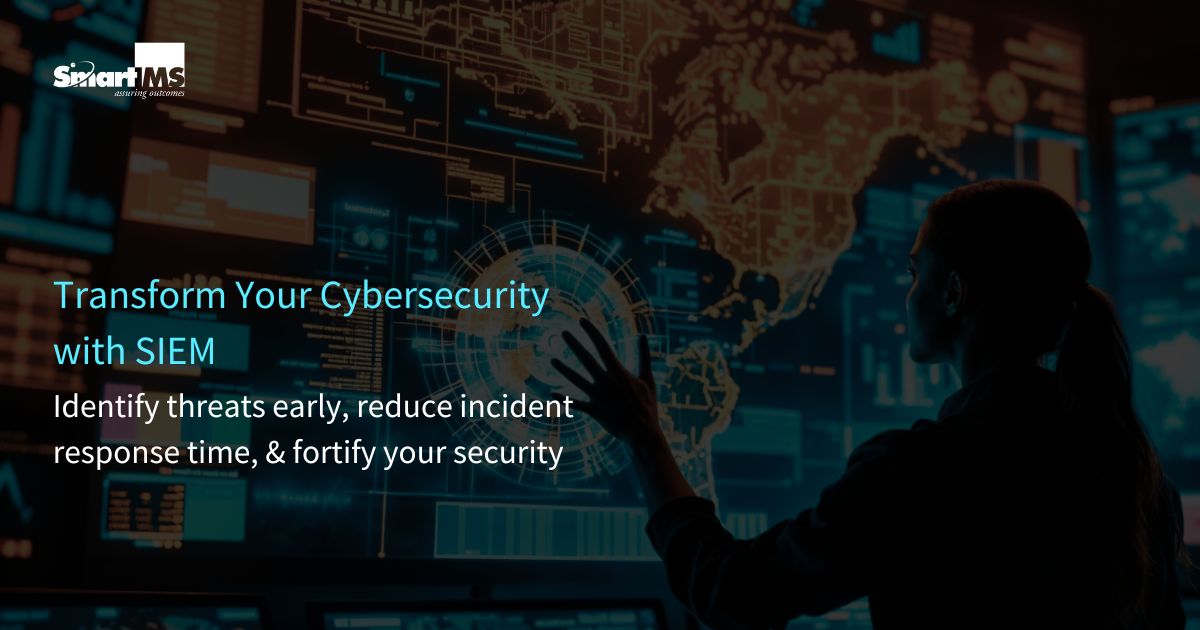Most breaches remain undetected for over 200 days, giving hackers ample time to steal sensitive data, compromise systems, and disrupt operations. The question is: how do organizations fight an enemy they can’t see?
The answer lies in Security Information and Event Management (SIEM)—a proactive cybersecurity approach that brings real-time visibility, threat detection, and incident response to the forefront. By centralizing security data from across an organization’s IT infrastructure, SIEM acts as the digital watchtower, spotting anomalies before they escalate into full-blown crises.
But SIEM is more than just a tool; it’s a strategy. To fully leverage its capabilities, organizations must understand its core functions, benefits, challenges, and best practices.
Let’s dive in.
What is SIEM?
Security Information and Event Management (SIEM) is a comprehensive security solution that collects, analyzes, and correlates security data from various sources—firewalls, servers, applications, intrusion detection systems, and more.
Think of SIEM as a security command center that helps in managing cyber security risks:
- It aggregates logs and events from different systems.
- It analyzes patterns to detect suspicious activities.
- It generates real-time alerts when potential threats arise.
- It assists in compliance reporting for regulatory standards like GDPR, HIPAA, and SOC 2.
By offering a bird’s-eye view of security events, SIEM empowers security teams to detect and respond to cyber threats with speed and precision.
Now, let’s go through the benefits of SIEM cybersecurity tool.
Why SIEM Matters: 5 Key Benefits
- Real-Time Threat Detection and Response
SIEM continuously monitors logs and events, analyzing them for anomalies and indicators of compromise (IoCs). For example- If an employee’s credentials are being used from two different locations within minutes, SIEM raises an alarm—potentially stopping a credential theft attack before damage is done.
- Centralized Visibility Across IT Infrastructure
Modern enterprises operate in complex, distributed environments—on-premises, cloud, hybrid, and remote setups. SIEM consolidates data from all endpoints, ensuring that no security event goes unnoticed. This single-pane-of-glass visibility simplifies security monitoring and decision-making, helping in managing cybersecurity risks.
- Automated Incident Response
Time is critical in cybersecurity. Many SIEM cybersecurity platforms integrate with Security Orchestration, Automation, and Response (SOAR) tools, automating threat responses. For instance, if SIEM detects malware on an endpoint, it can automatically isolate the infected machine—stopping lateral movement before it spreads.
- Regulatory Compliance & Audit Readiness
Industries like finance, healthcare, and retail face stringent compliance requirements. SIEM helps organizations meet standards like PCI-DSS, HIPAA, and ISO 27001 by maintaining detailed logs, generating reports, and demonstrating security control effectiveness.
- Reduced Dwell Time of Threats
Dwell time refers to how long a threat remains undetected. The shorter it is, the less damage a cyberattack can inflict. SIEM reduces dwell time by correlating events across multiple sources, identifying attacks early, and enabling quick remediation.
Now that we understand the importance of SIEM, let’s take a look at the challenges businesses face while implementing it.
Challenges in SIEM Implementation
Despite its advantages, SIEM is not a plug-and-play solution. Organizations face several hurdles in implementation: Below are some-
- High Volume of Alerts (Alert Fatigue)
SIEM generates thousands of alerts daily. Many are false positives, overwhelming security teams and causing alert fatigue. Without proper tuning, teams may ignore genuine threats amid the noise.
- Complex Deployment & Configuration
Configuring SIEM requires expertise in log management, event correlation, and security policies. Poor implementation can lead to misconfigured rules, missing threats, or excessive false positives.
- Data Overload & Storage Costs
SIEM collects vast amounts of log data, requiring high storage capacity and scalable infrastructure. If not managed properly, excessive logging can increase operational costs and slow down analysis.
- Skilled Workforce Requirement
SIEM tools need skilled security analysts who can interpret data, refine detection rules, and respond effectively. The global cybersecurity skills gap makes it challenging to find and retain qualified SIEM professionals.
- Integration with Legacy Systems
Many organizations use legacy systems that lack SIEM-friendly log formats, making integration difficult. Ensuring compatibility across different technologies requires custom log parsing and additional development work.
Now, let’s take a look at the steps that you can take to mitigate the challenges effectively.
Steps You Can Take to Mitigate the Above Challenges
While SIEM implementation comes with its challenges, organizations can take strategic steps to overcome them and maximize the tool’s efficiency. Here’s how:
- Fine-Tune Alerts to Reduce False Positives
Alert fatigue from excessive false positives can overwhelm security teams, leading to missed threats. Organizations should fine-tune SIEM rules and prioritize alerts based on risk severity. Machine learning-driven threat detection helps reduce unnecessary noise.
Regularly refining detection rules and eliminating redundant alerts ensures teams focus on real threats. Adjusting thresholds and optimizing correlation engines improve accuracy, preventing security teams from being overloaded with irrelevant notifications.
- Simplify Deployment with a Structured Approach
SIEM deployment is complex, and integrating all data sources at once can lead to inefficiencies. A phased approach, starting with critical logs, simplifies implementation while allowing gradual optimization. Using vendor-provided templates reduces misconfigurations.
Regular health checks and performance tuning enhance detection accuracy and system efficiency. By refining configurations over time, organizations can prevent alert overload and ensure effective security monitoring from the start.
- Manage Data Overload with Smart Storage Strategies
SIEM platforms generate vast amounts of log data, increasing storage costs and slowing performance. Smart log filtering helps collect only relevant security events, reducing unnecessary data accumulation. A tiered storage approach optimizes cost and accessibility.
Frequently accessed logs should be stored in high-performance environments, while older logs can be archived in cost-effective solutions. Cloud-based SIEM provides scalable storage, ensuring efficient log management without excessive overhead.
- Address the Skilled Workforce Shortage
SIEM tools require skilled professionals, but the cybersecurity talent gap makes hiring difficult. Organizations should invest in continuous training programs to upskill existing security teams and improve incident response capabilities.
Automating routine tasks with SOAR reduces manual workload, allowing analysts to focus on complex threats. Partnering with MSSPs can provide expert monitoring, ensuring efficient SIEM operations without relying solely on in-house talent.
- Ensure Seamless Integration with Legacy Systems
Legacy systems often lack SIEM-compatible log formats, making integration challenging. Custom log parsers and middleware solutions can help convert legacy logs into readable formats, ensuring compatibility with modern SIEM tools.
Selecting SIEM solutions with built-in connectors simplifies integration across diverse technologies. Regular infrastructure assessments help identify outdated systems that need upgrades, ensuring seamless security operations without disruptions.
Cyber threats are inevitable, but data breaches don’t have to be. SIEM offers organizations a proactive way to detect, analyze, and neutralize cyber threats before they cause irreversible damage. By providing real-time visibility, automated response, and compliance support, SIEM serves as the backbone of modern cybersecurity strategies. At Smart IMS, we provide AI-driven SIEM services that enhance threat intelligence, streamline response workflows, and ensure 24/7 protection against cyber threats.
Let’s understand.
Smart IMS SIEM Tool: Advanced Security & Compliance
Key Features of Smart IMS’s SIEM Tool:
- Multiple Threat Intel – Integrates data from various threat sources for real-time threat detection.
- Network Behavior Anomaly Detection (NBAD) & Network Traffic Analysis (NTA) – Identifies unusual network behavior and potential security incidents.
- Intrusion Detection & Prevention System (IDS/IPS) & Network Detection and Response (NDR) with Log Servers – Ensures real-time monitoring and automated threat mitigation.
- Vulnerability Assessment (VA) – Continuously scans and identifies security gaps across IT infrastructure.
- Endpoint Detection & Response (EDR) Services – Provides real-time threat monitoring and response at the endpoint level.
- Security Orchestration, Automation, and Response (SOAR) – Automates security workflows, reducing response times.
- User and Entity Behavior Analytics (UEBA) – Detects insider threats by analyzing deviations in user behavior.
Why Smart IMS? The Benefits We Deliver
- Unparalleled Noise Reduction – Cuts 95% of false positives, surfacing only actionable alerts for security teams.
- Always-On Security Monitoring – Provides 24/7 visibility across assets, users, and applications, ensuring real-time risk management.
- Rapid Deployment with Minimal Disruption – Our SIEM tool is operational within hours to days, even for enterprises managing thousands of assets.
- Early Threat Detection & Prevention – Proactively identifies ransomware, data breaches, DDoS attacks, and APTs (Advanced Persistent Threats) at their earliest stages.
- Intelligent & Automated Remediation – Deploys predefined SOAR playbooks to rapidly contain threats and mitigate cyber incidents with full control and flexibility.
- Effortless Compliance Management – Instantly generates audit-ready compliance reports for industry standards, including CMM, NIST, GDPR, PCI-DSS, and HIPAA—all in a single click.
Are you ready to fortify your security posture? Get in touch with us today and take the first step toward a smarter, stronger defense.



